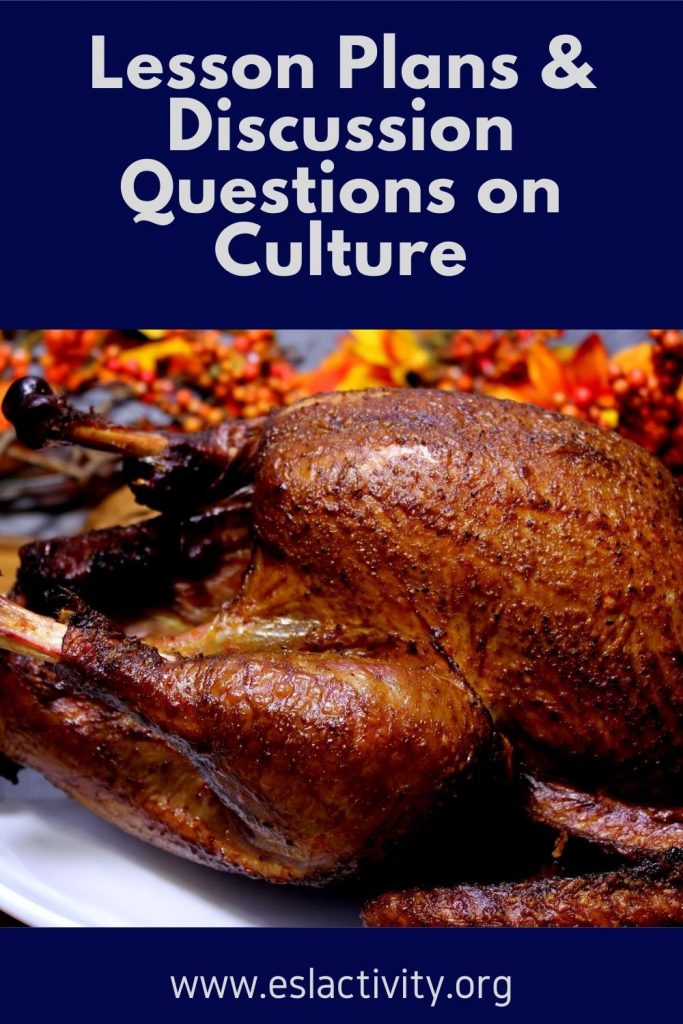If you’re looking for all things ESL culture, including lesson plans or cultural questions, then you’re certainly in the right place. Keep on reading for all the details you need to know about cultural conversation lessons, holiday activities, worksheets and more.

Culture lesson plans
ESL Culture Lesson: Games and Activities
Let’s get into the best ideas for teaching about culture to English learners. For the theory behind all of this, check out, What is the Relationship Between Language and Culture?
#1: ESL Culture Problem/Advice Board Game
This is a nice activity to do if all the students in your class are from the same country. Make up a board filled with small problems that a newcomer to their country might have. For example:
- I don’t want to be rude when going out to eat with my boss.
- How can I ask a girl I like out on a date?
- My neighbour keeps coming over to hang out but I don’t really like him. What can I do?
Then, students have to give some advice to that person when landing on the square. It’s easy to make your own game in just a few minutes. Find out all the details here:
https://eslactivity.org/problem-advice-board-game/
#2: ESL Culture Survey
Just ask my students and they’ll tell you that I love to use surveys in my classes. They’re interactive, cover a range of skills and can be used for just about any topic, including talking about culture.
In this case, surveys are best used when there are students from a variety of different cultures in your class. If everyone is from the same place, the answers will be almost the same, although you could form some questions exploring what people do on popular holidays for example.
Have a look here to find out how to make your own ESL survey and how to use them effectively in class:
https://eslactivity.org/esl-surveys/
#3: Cultural Presentations
Have students research and create presentations about their own culture or a specific culture of interest. They can share information about traditions, customs, festivals, food, clothing, and other cultural aspects.
#4: ESL Culture Family Tree Activity
Getting students to make and then explain a family tree can be a very interesting activity if you want to get a glimpse of how different cultures view family structure. I’ve been teaching for a lot of years and I have to admit that I’m still surprised every so often during this activity! Find out all about it here, along with some other ideas for this popular uni in ESL books:
https://eslactivity.org/esl-family-activities/
#5: ESL Thanksgiving Activities
A nice way to introduce American, Canadian or European culture to students from other places is to do a lesson on Thanksgiving. There are so many traditions surrounding this, and of course, the food! Here are some of the best games and activities, along with lesson plans and other resources for teaching students from different cultures about Thanksgiving:
https://eslactivity.org/thanksgiving-esl-activities/
#6: Current Events ESL Culture Lesson Plan
I love to talk about currents events in other countries in my classes! There are so many interesting stories of things happening around the world that can give great insight into various cultures. Here’s a current events lesson plan that you might want to check out:
https://eslactivity.org/current-events-lesson-plan/
#7: Man/Woman on the Street Interview Activity
If you have students from different cultures in a single class, a fun exercise can be this interview one. Have students think of some interesting culture questions that they’d like to interview the class about. Then, get to the interviewing! There are various ways to do it. Have a look at all the options here:
https://eslactivity.org/interview-activity/
#8: Cultural Comparisons
Engage students in discussions or writing exercises where they compare and contrast cultural practices, norms, or values between their own culture and the target culture. This promotes cultural understanding and fosters critical thinking skills.
#9: English Idiom Activity
Idioms are one of those things that are almost impossible to translate from language to language! They are very unique to each culture and can make an interesting lesson. One of the best ways to make English idioms more memorable is to do this activity:
https://eslactivity.org/idiom-activity-for-esl-students/
#10: Daily Routines ESL Activities
The basics of what people do on a daily basis are much the same around the world. However, there are some key differences which of course depend on culture. An interesting topic if you have students from many different countries is daily routines. Here are some of the best recommendations:
https://eslactivity.org/daily-routines-esl/
#11: Christmas ESL Activities
I love to celebrate Christmas with my students as it is a big part of my culture. There are lots of fun things to do for both kids as well as adults. Take a look at some of the best ideas:
https://eslactivity.org/esl-christmas-activities/
#12: Halloween ESL Lesson
Out of all the North American holidays, Halloween is one of my favourites! I like to have a small Halloween party with my students, doing all the traditional things! Check out some ideas for a school Halloween party or a Halloween focused lesson:
https://eslactivity.org/halloween-esl-activities/
#13: Cultural Interviews
Pair students from different cultural backgrounds and have them interview each other. They can ask questions about cultural traditions, family life, celebrations, or any topic of interest. Afterward, students can present their findings to the class.
#14: Culture Reading Lesson Plan
I like to do some reading-focused lessons in my general English classes. In this case, I’d find a reading passage related to culture. It would be a story about conflict between people of two cultures, someone experiencing culture shock, or perhaps someone talking about the differences in culture between their home country and their new country.
Then, there is a number of things to include in a lesson like this. Here are some of them to consider:
https://eslactivity.org/an-esl-reading-lesson-plan-template/
#15: Easter ESL Activities
Easter is another one of those holidays that’s very popular in North America and in many other places around the world. It has its’ own special food and cultural traditions too. For an Easter focused English lesson, have a look at my top recommendations:
https://eslactivity.org/easter-esl-activities/

Culture questions to ask students
#16: Cultural Artifacts
Bring in cultural artifacts, such as traditional clothing, musical instruments, or artifacts related to food, and encourage students to explore and discuss their significance. This hands-on approach helps students connect with different cultures.
#17: Cultural Food Tasting
Organize a cultural food-tasting event where students bring in dishes from their own cultures or research and prepare dishes from a specific culture. This activity allows students to experience and appreciate different cuisines.
#18: Cultural Music and Dance
Introduce students to music and dance from various cultures. Play traditional music and teach simple dance steps or have students research and present on different musical styles and dance forms.
#19: Cultural Storytelling
Share folktales, myths, or legends from different cultures. Discuss the values, morals, or lessons conveyed in these stories. Students can also create their own stories inspired by their culture or the target culture.
#20: Virtual Cultural Tours
Use online resources and virtual tours to explore famous landmarks, museums, or cultural sites from different countries. Engage students in discussions and reflection on what they discover.
#21: Cultural Role-plays
Assign students roles in a cultural scenario, such as ordering food in a restaurant, participating in a festival, or greeting someone from a different culture. This role-play activity helps develop cultural awareness and communication skills.
ESL Culture Lesson Plans
Whenever possible, I like to use lessons that other teachers have already created! It can save a ton of time and why reinvent the wheel if you don’t have to, right? Here are some of the best ESL lesson plans on culture to consider:
ESL Cultural Lesson Worksheets
If you’re a teacher then you’ll already know what a timesaver it can be to use resources that other teachers have already made. Check out these ESL culture worksheets for some of my top recommendations:
Discussion Questions about Culture
If you want to get the conversation ball rolling, it’s helpful to start with some great questions. Check out these cultural questions to use with your English learners:
Did you like these ESL Culture Lesson Ideas?
- Amazon Kindle Edition
- Bolen, Jackie (Author)
- English (Publication Language)
- 187 Pages - 03/09/2016 (Publication Date)
Yes? Then you’re going to love this book that you can find over on Amazon: 101 ESL Activities for Teenagers and Adults. One of the keys to better English classes for teens or adults is a wide variety of interesting, interactive and engaging ESL games and activities and this book will certainly help you achieve that.
Keep a copy on the bookshelf in your office to use as a handy reference guide. Or, take the digital version with you on any device with the free Kindle reading app to your favourite coffee shop for some lesson planning on the go. Finally, consider listening to the audio version while commuting to work for a serious dose of inspiration.
Whatever the case, you’re going to have to get ready for some ESL teaching awesome in your life. Are you ready? Head over to Amazon to find out all the details you need to know and to pick up your copy today:
Language and Culture FAQs
There are a number of common questions that people about language and culture. Here are the answers to some of the most popular ones.
What is the relationship between language and culture?
Language and culture are directly intertwined and the relationship between them cannot be separated. It’s impossible to understand a culture without knowing some of the language and vice-versa. Learning a language not only involves vocabulary and grammar rules but knowing about a society’s customs as well.
Why is language important to culture?
Language is important to culture and the two cannot be separated. Language is vital as a way to communicate values, beliefs, and customs. Language also fosters group identity and is the means by which traditions and shared values are conveyed and passed down from generation to generation.
Is language a part of culture?
Language is certainly a part of culture but it’s also a means by which culture is transmitted from person to person and generation to generation. It’s impossible to separate the two things.
How do you teach culture in the English classroom?
Many English teachers are tasked with teaching not only the English language but western culture as well in the classroom. This can be done by comparing the teacher’s culture with that of the students, talking about food and holidays, using authentic materials including songs as well as introducing students to people who live in your country.
How does culture influence English language learning?
Culture influences English language learning in a big way in that vocabulary in particular requires an understanding of the culture in order to truly grasp the meaning of it. It’s possible to learn words and grammar rules but until you learn about the culture, you won’t fully grasp the language as a whole.
Have your say about Teaching Culture for ESL
What do think about teaching culture along with language? Please leave a comment below and let us know what you think. We’d love to hear from you.
Also be sure to give this article a share on Facebook, Pinterest, or Twitter. It’ll help other busy English teachers, like yourself find this useful resource.

Cultural lesson plans
Last update on 2022-07-17 / Affiliate links / Images from Amazon Product Advertising API





